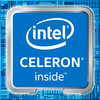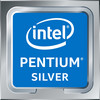Intel Celeron J4105 vs Intel Celeron J4005 vs Intel Pentium Silver N5030
Intel Celeron J4105
► remove from comparison
The Intel Celeron J4105 is a quad-core desktop SoC primarily for mini PCs and mini ITX mainboards. It runs at 1.5 - 2.5 GHz (Single Core Burst) and is based on the Gemini Lake platform. Similar to the Apollo Lake predecessor, the chip is manufactured in a 14 nm process with FinFETs but offers slightly improved processor cores, double the amount of L2 cache, a smaller package, a new generation of monitor outputs (Gen 10) and a partly integrated WiFi chip. Besides four CPU cores, the chip also includes a DirectX 12 capable GPU as well as a DDR4/LPDDR4 memory controller (dual-channel, up to 2400 MHz). The SoC is not replaceable as it is directly soldered to the mainboard.
Architecture
The processor architecture was slightly reworked and is now called Goldmont Plus. It features an increased level 2 cache (to 4 MB). That means the per-clock-performance should be a bit better, but not near the Core CPUs like Kaby Lake Y.
Performance
While we have not tested a single system built around the J4105 as of August 2023, we have tested a certain number of laptops featuring the Celeron N4120, a chip with very similar specs (4 cores, 4 threads, up to 2.6 GHz). Based on that, expect the J4105 to be very slow in all but the most basic activities.
Intel Celeron J4005
► remove from comparisonThe Intel Celeron J4005 is a dual-core desktop SoC primarily for mini PCs and mini ITX mainboards. It runs at 2 - 2.7 GHz (Single Core Burst) and is based on the Gemini Lake platform. Similar to the Apollo Lake predecessor, the chip is manufactured in a 14 nm process with FinFETs but offers slightly improved processor cores, double the amount of L2 cache, a smaller package, a new generation of monitor outputs (Gen 10) and a partly integrated WiFi chip. Besides four CPU cores, the chip also includes a DirectX 12 capable GPU as well as a DDR4/LPDDR4 memory controller (dual-channel, up to 2400 MHz). The SoC is not replaceable as it is permanently soldered to the mainboard.
Architecture
The processor architecture was slightly reworked and is now called Goldmont Plus. It features an increased level 2 cache (to 4 MB). That means the per-clock-performance should be a bit better, but not anywhere near the Core CPUs like Kaby Lake Y.
Performance
The average J4005 in our database is in the same league as the Celeron N3450 and the Celeron 3865U, as far as multi-thread benchmark scores are concerned. This is an abysmally poor result, as of early 2023.
Power consumption
This Celeron series chip has a default TDP, also known as the long-term power limit, of 10 W. That's not much at all and thus good enough for passively cooled tablets, laptops and mini-PCs.
The J4005 is built with one of Intel's old 14 nm processes for poor, as of early 2023, energy efficiency.
Intel Pentium Silver N5030
► remove from comparison
The Intel Pentium Silver N5030 is a quad-core SoC primarily for inexpensive notebooks and was announced late 2019. It runs at 1.1-3.1 GHz (Single Core Burst) and is based on the Gemini Lake platform. The 5030 is the refresh of the older Pentium 5000 and offers a 400 MHz higher Boost clock. Similar to the Apollo Lake predecessor, the chip is manufactured in a 14 nm process with FinFETs but offers slightly improved processor cores, double the amount of L2 cache, a smaller package, a better GPU architecture and a partly integrated WiFi support. Besides four CPU cores, the chip also includes a DirectX 12 capable GPU as well as a DDR4/LPDDR4 memory controller (dual-channel, up to 2400 MHz). The SoC is not replaceable as it is directly soldered to the mainboard.
Architecture
The processor architecture is still called Goldmont Plus. Compared to the older Goldmont cores in Apollo Lake, they feature an increased level 2 cache (to 4 MB). That means the per-clock-performance should be a bit better, but not near the Core CPUs like Kaby Lake Y.
Performance
The average N5030 in our database proves unable to beat the AMD 3020e, an entry-level dual-core CPU of similar power efficiency, in multi-thread performance, rendering the Pentium a poor option for anything but the most basic day-to-day activities, as of late 2022.
GPU Performance
The UHD Graphics 605 (Gemini Lake) is based on Intel's Gen9 architecture, which supports DirectX 12 and is also used for the Kaby Lake / Skylake / Apollo Lake graphics adapters (like HD Graphics 520). Equipped with 18 EUs and a clock of up to 750 MHz, the performance should be roughly on par with the older HD Graphics 5300 and HD Graphics 505 (Apollo Lake).
The chip also includes an advanced video engine with hardware support for the playback of VP9 and H.265 material (8-bit color-depth).
Power consumption
Like most N-class Intel chips, the Pentium has a default TDP, also known as the long-term power limit, of 6 W. This is low and thus good enough for passively cooled tablets, laptops, mini-PCs and handhelds.
The Intel Pentium N5030 is built with one of the old 14 nm Intel processes making for poor, as of early 2023, energy efficiency.
| Model | Intel Celeron J4105 | Intel Celeron J4005 | Intel Pentium Silver N5030 | ||||||||||||||||||||||||||||||||||||||||||||||||||||||||||||||||||||||||
| Series | Intel Gemini Lake | Intel Gemini Lake | Intel Gemini Lake | ||||||||||||||||||||||||||||||||||||||||||||||||||||||||||||||||||||||||
| Codename | Gemini Lake | Gemini Lake | Gemini Lake Refresh | ||||||||||||||||||||||||||||||||||||||||||||||||||||||||||||||||||||||||
| Series: Gemini Lake Gemini Lake Refresh |
|
|
| ||||||||||||||||||||||||||||||||||||||||||||||||||||||||||||||||||||||||
| Clock | 1500 - 2500 MHz | 2000 - 2700 MHz | 1100 - 3100 MHz | ||||||||||||||||||||||||||||||||||||||||||||||||||||||||||||||||||||||||
| L2 Cache | 4 MB | 4 MB | 4 MB | ||||||||||||||||||||||||||||||||||||||||||||||||||||||||||||||||||||||||
| Cores / Threads | 4 / 4 | 2 / 2 | 4 / 4 | ||||||||||||||||||||||||||||||||||||||||||||||||||||||||||||||||||||||||
| TDP | 10 Watt | 10 Watt | 6 Watt | ||||||||||||||||||||||||||||||||||||||||||||||||||||||||||||||||||||||||
| Technology | 14 nm | 14 nm | 14 nm | ||||||||||||||||||||||||||||||||||||||||||||||||||||||||||||||||||||||||
| max. Temp. | 105 °C | 105 °C | 105 °C | ||||||||||||||||||||||||||||||||||||||||||||||||||||||||||||||||||||||||
| Socket | BGA1090 | BGA1090 | BGA1090 | ||||||||||||||||||||||||||||||||||||||||||||||||||||||||||||||||||||||||
| Features | DDR4-2400/LPDDR4-2400 RAM, PCIe 2, MMX, SSE, SSE2, SSE3, SSSE3, SSE4.1, SSE4.2, VMX, SMEP, SMAP, MPX, EIST, TM1, TM2, Turbo, AES-NI, RDRAND, RDSEED, SHA, SGX | DDR4-2400/LPDDR4-2400 RAM, PCIe 2, MMX, SSE, SSE2, SSE3, SSSE3, SSE4.1, SSE4.2, VMX, SMEP, SMAP, MPX, EIST, TM1, TM2, Turbo, AES-NI, RDRAND, RDSEED, SHA, SGX | DDR4-2400/LPDDR4-2400 RAM, PCIe 2, MMX, SSE, SSE2, SSE3, SSSE3, SSE4.1, SSE4.2, VMX, SMEP, SMAP, MPX, EIST, TM1, TM2, Turbo, AES-NI, RDRAND, RDSEED, SHA, SGX | ||||||||||||||||||||||||||||||||||||||||||||||||||||||||||||||||||||||||
| iGPU | Intel UHD Graphics 600 (250 - 750 MHz) | Intel UHD Graphics 600 (250 - 700 MHz) | Intel UHD Graphics 605 (200 - 750 MHz) | ||||||||||||||||||||||||||||||||||||||||||||||||||||||||||||||||||||||||
| Architecture | x86 | x86 | x86 | ||||||||||||||||||||||||||||||||||||||||||||||||||||||||||||||||||||||||
| $107 U.S. | $107 U.S. | ||||||||||||||||||||||||||||||||||||||||||||||||||||||||||||||||||||||||||
| Announced | |||||||||||||||||||||||||||||||||||||||||||||||||||||||||||||||||||||||||||
| Manufacturer | ark.intel.com | ark.intel.com | ark.intel.com | ||||||||||||||||||||||||||||||||||||||||||||||||||||||||||||||||||||||||
| L1 Cache | 112 KB |


 Deutsch
Deutsch English
English Español
Español Français
Français Italiano
Italiano Nederlands
Nederlands Polski
Polski Português
Português Русский
Русский Türkçe
Türkçe Svenska
Svenska Chinese
Chinese Magyar
Magyar
